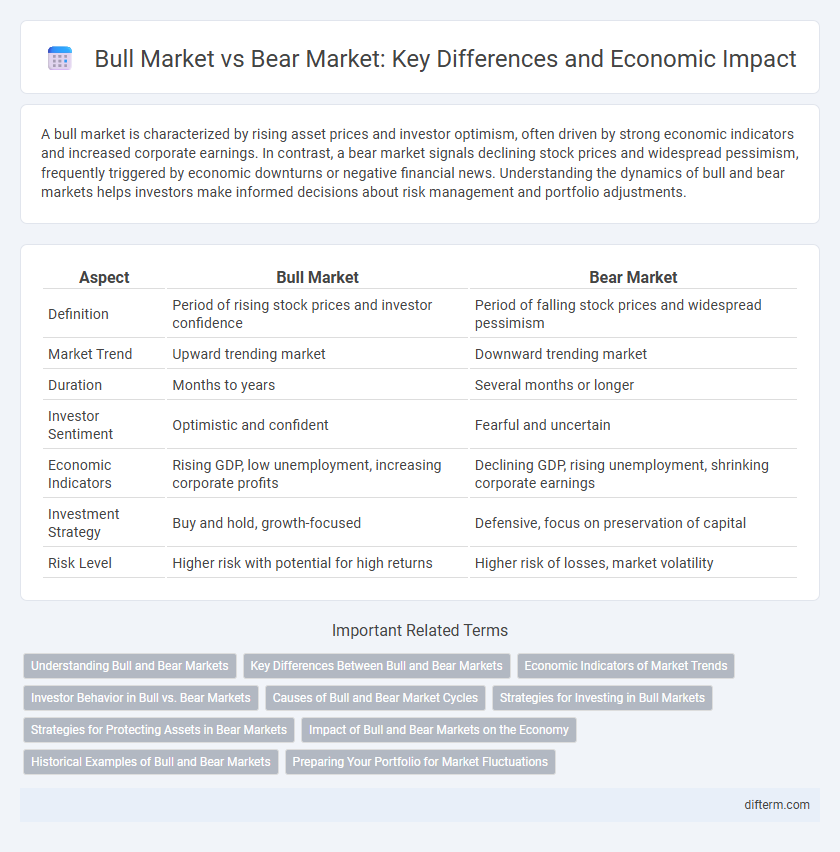A bull market is characterized by rising asset prices and investor optimism, often driven by strong economic indicators and increased corporate earnings. In contrast, a bear market signals declining stock prices and widespread pessimism, frequently triggered by economic downturns or negative financial news. Understanding the dynamics of bull and bear markets helps investors make informed decisions about risk management and portfolio adjustments.
Table of Comparison
| Aspect | Bull Market | Bear Market |
|---|---|---|
| Definition | Period of rising stock prices and investor confidence | Period of falling stock prices and widespread pessimism |
| Market Trend | Upward trending market | Downward trending market |
| Duration | Months to years | Several months or longer |
| Investor Sentiment | Optimistic and confident | Fearful and uncertain |
| Economic Indicators | Rising GDP, low unemployment, increasing corporate profits | Declining GDP, rising unemployment, shrinking corporate earnings |
| Investment Strategy | Buy and hold, growth-focused | Defensive, focus on preservation of capital |
| Risk Level | Higher risk with potential for high returns | Higher risk of losses, market volatility |
Understanding Bull and Bear Markets
Bull markets are characterized by rising stock prices, investor confidence, and economic growth, typically lasting months or years with sustained upward trends. Bear markets, conversely, involve declining stock prices, widespread pessimism, and economic contraction, often triggered by recessions or external shocks. Understanding the indicators and investor behavior during these market phases is crucial for strategic portfolio management and risk assessment.
Key Differences Between Bull and Bear Markets
Bull markets are characterized by rising stock prices, investor confidence, and strong economic growth, often leading to increased spending and higher corporate profits. Bear markets feature declining stock prices, widespread pessimism, and economic contraction, resulting in reduced consumer spending and lower earnings. Key differences include market sentiment, duration, and impact on investment strategies, with bull markets encouraging buying and bear markets prompting caution or selling.
Economic Indicators of Market Trends
Economic indicators such as GDP growth rate, unemployment figures, and consumer confidence indexes play a critical role in distinguishing bull markets from bear markets. Rising corporate earnings, increasing stock prices, and strong industrial production typically signal a bull market, whereas declining sales, higher unemployment rates, and reduced manufacturing output often indicate a bear market. Market sentiment reflected in volatility indexes and bond yield curves also provides valuable insights into trend reversals between bullish and bearish phases.
Investor Behavior in Bull vs. Bear Markets
Investor behavior in bull markets is characterized by increased confidence, higher risk tolerance, and a tendency to buy assets anticipating rising prices, which often drives further market gains. In contrast, bear markets trigger risk aversion, reduced trading activity, and a preference for safer investments like bonds or cash, as fear of losses dominates decision-making. Understanding these behavioral shifts is crucial for strategic portfolio management and timing market entry or exit.
Causes of Bull and Bear Market Cycles
Bull market cycles are primarily driven by strong economic fundamentals, rising corporate profits, and increased investor confidence, often fueled by low interest rates and robust consumer spending. Bear market cycles typically result from economic recessions, declining corporate earnings, tightening monetary policies, and heightened market uncertainty or geopolitical risks. Shifts in inflation rates and changes in fiscal policies also play critical roles in transitioning between these market phases.
Strategies for Investing in Bull Markets
In bull markets, investors should prioritize growth stocks and increase exposure to sectors showing robust earnings momentum, such as technology and consumer discretionary. Employing a strategy centered on momentum investing can capitalize on rising asset prices, while maintaining a diversified portfolio mitigates risk during market fluctuations. Consistent monitoring of economic indicators like GDP growth rates and corporate earnings reports helps optimize entry and exit points for maximizing returns.
Strategies for Protecting Assets in Bear Markets
In bear markets, investors prioritize capital preservation by reallocating assets into defensive sectors like utilities and consumer staples, which historically exhibit lower volatility during downturns. Diversification through bonds, gold, and cash equivalents reduces risk exposure and minimizes losses amid declining equity values. Employing stop-loss orders and hedging strategies, such as options or inverse ETFs, provides additional layers of protection against sustained market declines.
Impact of Bull and Bear Markets on the Economy
Bull markets drive economic growth by boosting investor confidence, increasing wealth, and encouraging consumer spending, which supports job creation and business expansion. Bear markets often trigger reduced spending, heightened market volatility, and increased risk aversion, leading to slower economic growth, higher unemployment, and decreased corporate profits. Both market conditions significantly influence fiscal policies, investment strategies, and overall economic stability.
Historical Examples of Bull and Bear Markets
The 1920s Roaring Bull Market ended abruptly with the 1929 crash, leading to the Great Depression and a prolonged bear market throughout the 1930s. The dot-com bubble of the late 1990s exemplified a bull market fueled by technology stocks, which collapsed in 2000 causing a severe bear market. More recently, the 2008 financial crisis triggered a major bear market, followed by a record-breaking bull market lasting over a decade until the COVID-19 pandemic-induced bear market in early 2020.
Preparing Your Portfolio for Market Fluctuations
Preparing your portfolio for market fluctuations involves diversifying assets to balance risk during both bull and bear markets. Incorporating a mix of equities, bonds, and alternative investments can help protect against volatility and capitalize on growth opportunities. Regularly rebalancing your portfolio ensures alignment with long-term financial goals while adapting to changing market conditions.
bull market vs bear market Infographic

 difterm.com
difterm.com